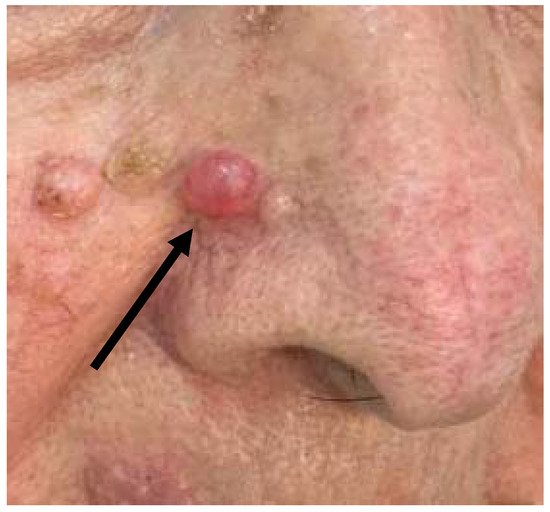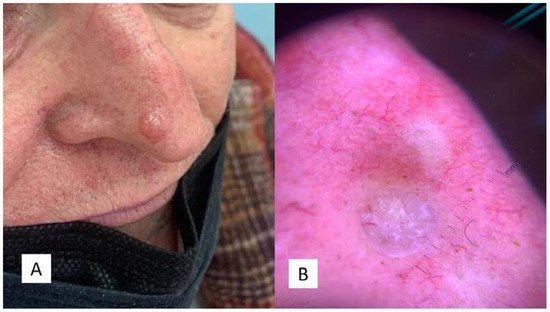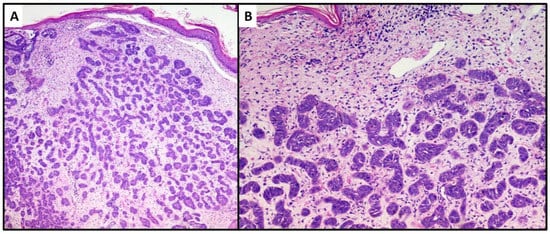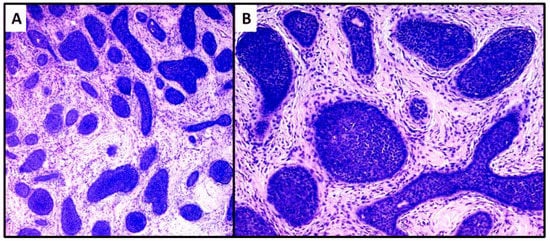Trichoblastoma is a rare benign tumor of the follicular germ cells, in which follicle development may be partly or completely replicated
[4]. It was first described by Headington as a differentiated follicular neoplasm
[5]. In the following years, different nomenclatures were adopted, including “trichogenic tumor”
[6] or “trichogenic trichoblastoma”
[7]. In a 1995 review, Schirren et al.
[8] reviewed the knowledge of this entity and since then, the term Trichoblastoma has been exclusively used. Usually, a Trichoblastoma measures more than 1 cm in diameter and may involve the deep dermis and/or subcutis
[9]. Our two new cases were also 1 cm or more, and both showed a tendency to infiltrate the deep dermis, and sometimes reach the subcutis. The parts of the body most affected are the head and neck districts
[2], although other localizations have also been reported, such as the vulva
[10]. In addition, various cases of lesions joining TB with other cutaneous neoplasms have been reported: for example, with inverted follicular keratosis
[11], or with syringocystoadenoma papilliferum in a common sebaceous nevus
[12], or again with a dilated pore of Winer
[13]. There has been much debate about the importance of identifying dermoscopic criteria that could allow a correct differential diagnosis between TB and BCC, but a recent 2020 review
[14] clarified that, despite the efforts of Ghigliotti et al.
[15] in demonstrating significantly more blue–gray ovoid nests and globules in BCC compared to TB, these features may also be present in TB, so a confirmatory histopathological diagnosis is still necessary today. Many, perhaps most, dermatopathologists regard trichoepithelioma (TE) as a variant of trichoblastoma (TB) with smaller aggregations of cells; indeed, conventional and desmoplastic trichoepithelioma have also been referred to as cribriform and columnar trichoblastoma, respectively
[2][6]. Requena L. et al., for example, consider trichoepithelioma to be a superficial variant of trichoblastoma, showing characteristics of a benign, symmetrical and well-defined tumor consisting mainly of germinative follicular cells embedded in an abundant fibrotic stroma
[6].
In the latest WHO 2018 “Skin Tumors” classification
[2], different variants of TB are recognized, making the differential diagnosis even more complex even for the dermatopathologist: nodular
[16] (as in our two cases), retiform, cribriform
[17], racemiform
[18] and columnar patterns of TB. Furthermore, rare variants of TB include clear cell
[18], pigmented (pigmented TB)
[19][20] and adamantinoid lesions
[21]. It is generally believed that another rare adamantine variant of TB is cutaneous lymphadenoma, a rare adnexal tumor with a prominent lymphocytic infiltrate in the tumor nests
[22][23]. In addition to histopathology, various scientific works
[24] have attempted to identify immunohistochemical markers that could reliably differentiate between TB and BCC, including CD34 positivity of the stroma fibrocytes in TB versus negative stroma fibrocytes in basal cell carcinoma
[25][26][27]; different BCL-2 expression, that is diffusely positive in epithelial cells of BCC but only marks the peripheral layer of cells in TB
[28][29]; finally, the number of CK20-positive Merkel cells, more abundant in TB than in BCC. Immunohistochemical expression of PHLDA1 (a marker of follicular stem cells) is positive in TB and completely negative in BCC
[30]; conversely, markers such as CD10, follistatin and Bmi-1 have not yet been shown to offer a safe differential diagnosis
[31]. Leonid Izikson et al. reported that expression of the androgen receptor could be more indicative of BCC than TB
[32].




